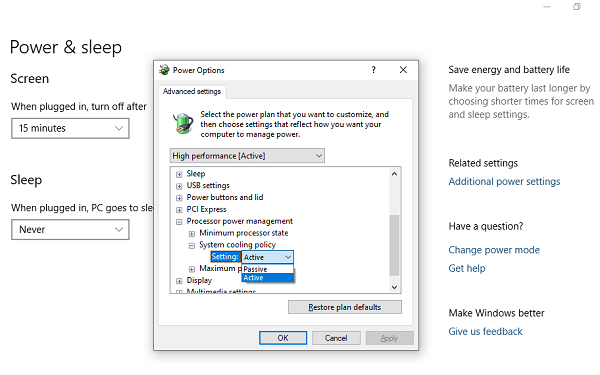Be it a Desktop or Laptop, it’s important to conserve power. One of the ways it can be done is by using the System Cooling Policy. Since Desktops are always plugged in, it becomes even necessary to save power when you are running on battery. That’s where the System Cooling Policy for Processor comes into play. Windows 11/10 offers two types of cooling policy— Passive and Active. In this post, we will share how you can change System Cooling Policy for Processor from Passive to Active or vice versa.
What is a Passive or Active System Cooling Policy for the Processor?
Before we go ahead and change it, let’s understand how Passive and Active cooling policy for processors works.
- Passive: It slows the processor before accelerating the fan speed
- Active: It increases the fan speed before slowing the processor
While the Passive method will slow down performance, its power-efficient. On the other hand, Active policy will be costly. However, if you are on Desktop, you can use Active, but if you are on Laptop, use Passive policy to save battery power.
That said, the OS activates them when required. ACPI feature in the OS enables the vendor to keep a check on temperature through sensors. When the temperature exceeds the thermal zone, the OS takes action to cool down the device.
How to change System Cooling Policy in Windows 11/10

To change System Cooling Policy for Processor from Passive to Active or vice versa in Windows 11/10:
- Go to Settings > System > Power and Sleep
- Click on Additional power settings
- Select the plan settings (Balanced/High performance) and click on change plan settings
- It will populate the list with all power-related option. Navigate to Processor power management > System cooling policy > Settings.
- Select Active or Passive, and then click on OK to apply the changes.
That said, some of the hardware vendors may not implement active cooling, especially on mobile devices, as it increases the cost and size of the hardware platform. It also drains the battery and makes more noise. On Laptops, the processor is throttled to reduce heat generation, which makes sense.
I hope these steps and explanations helped you understand the Active and Passive systems and how to change the system cooling policy for the processor.
System Cooling Policy missing; How to fix?
If the is missing on your Windows 11/10 computer, open an elevated command prompt, and execute the following command:
REG ADD HKLM\SYSTEM\CurrentControlSet\Control\Power\PowerSettings\54533251-82be-4824-96c1-47b60b740d00\94D3A615-A899-4AC5-AE2B-E4D8F634367F /v Attributes /t REG_DWORD /d 2 /f
Once you see The operation completed successfully message, restart your computer and see.
Leave a Reply